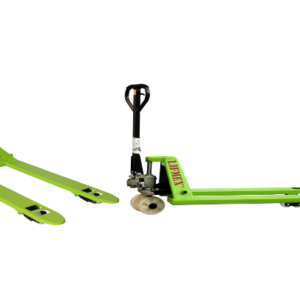A scissor pallet truck is an advanced type of material handling equipment designed to lift and move palletized loads efficiently. It combines the functions of a traditional pallet jack with the added benefit of a scissor lift mechanism, allowing for adjustable lifting heights and enhanced ergonomic handling.
Key Features:
- Scissor Lift Mechanism: The key feature of the scissor pallet truck is its scissor lift mechanism, which allows the pallet truck to elevate to various heights. This feature enhances ergonomics by reducing the need for manual lifting and bending, making it easier to handle loads at different heights.
- Hydraulic Operation: Most scissor pallet trucks utilize a hydraulic system to raise and lower the platform. The hydraulic pump is operated via a handle or lever, which controls the lift and descent of the truck, allowing for smooth and controlled adjustments.
- Heavy-Duty Construction: Built with robust materials such as high-strength steel, scissor pallet trucks are designed to handle heavy loads. They are engineered to provide stability and durability under demanding conditions, making them suitable for industrial and warehouse environments.
- Adjustable Height: The ability to adjust the height of the platform allows operators to position loads at the optimal working height, improving efficiency and reducing strain. This feature is particularly beneficial for tasks involving frequent load handling and sorting.
- Maneuverability: Equipped with large, heavy-duty wheels or casters, scissor pallet trucks offer smooth maneuverability across various floor surfaces. Some models feature swivel casters for enhanced steering and control in tight spaces.
- Safety Features: Designed with safety in mind, scissor pallet trucks often include features such as safety brakes, stabilizing mechanisms, and emergency stop controls to ensure safe operation and prevent accidents.
- Versatile Use: Suitable for a wide range of applications including lifting and transporting palletized goods, organizing warehouse inventory, and handling materials in production and distribution settings.
Applications:
- Warehouses and Distribution Centers: Used to lift and transport palletized goods, streamline material handling processes, and improve efficiency in inventory management.
- Manufacturing Facilities: Applied in production environments to handle components and products, facilitating easier access to materials and reducing manual labor.
- Retail and Storage: Employed in retail settings for managing stock and organizing products at various heights, enhancing accessibility and stock rotation.
- Loading and Unloading: Ideal for use in loading docks and shipping areas to raise pallets to the correct height for loading or unloading from trucks.
Benefits:
- Improved Ergonomics: Reduces the need for manual lifting and bending, minimizing physical strain on operators and improving workplace ergonomics.
- Increased Efficiency: Allows for quick and easy adjustment of load heights, facilitating faster and more efficient handling of materials.
- Enhanced Safety: Features such as safety brakes and stabilizers contribute to safer operation and reduced risk of accidents.
- Durability and Strength: Built to handle heavy loads and withstand rigorous use, providing long-lasting performance and reliability.



Reviews
There are no reviews yet.